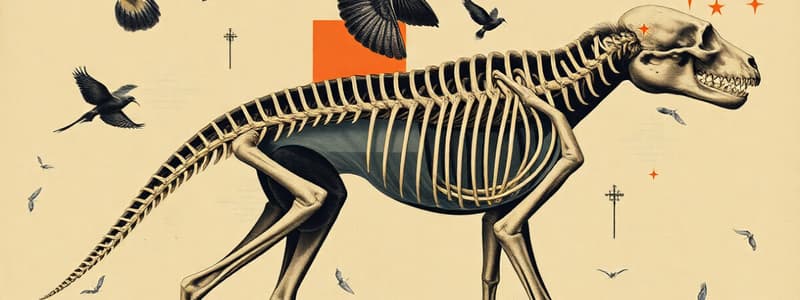Podcast
Questions and Answers
Which characteristic is NOT typically associated with vertebrates?
Which characteristic is NOT typically associated with vertebrates?
- Closed circulatory system
- Internal skeleton
- External fertilization (correct)
- Presence of a spinal cord
What is the primary function of the swim bladder in fish?
What is the primary function of the swim bladder in fish?
- To excrete waste products
- To detect movement in the water
- To regulate buoyancy in the water (correct)
- To filter oxygen from the water
How do bony fish primarily reproduce?
How do bony fish primarily reproduce?
- Ovoviviparously
- Externally via oviparity (correct)
- Asexually through budding
- Viviparously
What adaptation allows amphibians to supplement their rudimentary lungs?
What adaptation allows amphibians to supplement their rudimentary lungs?
What does it mean for amphibians to be 'not amniotic'?
What does it mean for amphibians to be 'not amniotic'?
Which characteristic is essential for reptiles to thrive in terrestrial environments?
Which characteristic is essential for reptiles to thrive in terrestrial environments?
What is the role of scales in reptiles?
What is the role of scales in reptiles?
How do sharks differ from bony fish in terms of skeletal composition?
How do sharks differ from bony fish in terms of skeletal composition?
What reproductive strategy is utilized by mammals?
What reproductive strategy is utilized by mammals?
How do amphibians use metamorphosis in their life cycle?
How do amphibians use metamorphosis in their life cycle?
What is the purpose of the lateral line in fish?
What is the purpose of the lateral line in fish?
Which of the following describes the main method of reproduction of reptiles?
Which of the following describes the main method of reproduction of reptiles?
What does it mean for fish to have tooth-like scales?
What does it mean for fish to have tooth-like scales?
What adaptation helps fish survive different levels of water pressure?
What adaptation helps fish survive different levels of water pressure?
What is a key difference between turtles and tortoises, based on their habitat?
What is a key difference between turtles and tortoises, based on their habitat?
Flashcards
Vertebrate Characteristics
Vertebrate Characteristics
Vertebrates have a spinal cord, an internal skeleton and closed circulatory system.
Vertebrate Nervous System
Vertebrate Nervous System
The central nervous system is composed of nerves and the central nervous system.
Vertebrate Reproduction
Vertebrate Reproduction
Vertebrates reproduce sexually and can be oviparous, viviparous, or ovoviviparous.
Fish Characteristics
Fish Characteristics
Signup and view all the flashcards
Swim Bladder
Swim Bladder
Signup and view all the flashcards
Lateral Line
Lateral Line
Signup and view all the flashcards
Shark Mouth Position
Shark Mouth Position
Signup and view all the flashcards
Bony Fish
Bony Fish
Signup and view all the flashcards
Amphibians Characteristics
Amphibians Characteristics
Signup and view all the flashcards
Amphibian Eggs
Amphibian Eggs
Signup and view all the flashcards
Cutaneous Respiration
Cutaneous Respiration
Signup and view all the flashcards
Amphibian Reproduction
Amphibian Reproduction
Signup and view all the flashcards
Amphibian Transformation
Amphibian Transformation
Signup and view all the flashcards
Covered skin is used by...
Covered skin is used by...
Signup and view all the flashcards
Reptile Eggs
Reptile Eggs
Signup and view all the flashcards
Study Notes
- Vertebrates are part of the Phylum Cordata.
- Vertebrates have a dorsal nerve cord.
- The phylum cordata include Urochordates, Cephalochordates, Fish, Amphibians, Reptiles, Birds, and Mammals.
Characteristics of Vertebrates
- Vertebrates possess a spinal cord, also known as médula espinal.
- Vertebrates have an internal skeleton.
- Vertebrates' nervous system has nerves and a central nervous system comprising the brain and spinal cord.
- Vertebrates have highly developed sense organs.
- Vertebrates have a closed circulatory system.
- They reproduce through sexual reproduction.
- Fish, birds, and amphibians are oviparous, laying eggs.
- Mammals are viviparous, with the embryo developing inside the mother.
- Some reptiles exhibit viviparity.
- Ovoviviparous animals produce eggs that develop and hatch inside the mother's body, giving birth to live young; some snakes and sharks do this.
Fish
- Aquatic vertebrates are ectothermic.
- Almost all fish are covered in scales.
- Almost all fish have fins.
- Many fish possess a swim bladder, an internal sac filled with gas for buoyancy control.
- A lateral line is a sense organ along the fish's body that detects movement.
Cartilaginous Fish
- Cartilaginous fish have cartilaginous skeletons.
- These fish lack a swim bladder.
- Their skin is covered with tooth-like scales.
- The mouth is in a ventral position.
- They use internal fertilization.
- Cartilaginous fish can be oviparous, viviparous, or ovoviviparous
Bony Fish
- Bony fish possess a bony skeleton.
- Bony fish have gills protected by an operculum.
- Bony fish use external fertilization.
- They are oviparous.
Amphibians
- Amphibians are ectothermic vertebrates with bare, moist skin.
- Amphibians depend on bodies of water.
- Amphibian eggs lack an amniotic membrane, so they must be laid in water.
- Larvae breathe through gills, while adults possess rudimentary lungs and depend on cutaneous respiration through moist skin.
- Amphibians use sexual reproduction with external fertilization and undergo metamorphosis.
- They hibernate during the winter, reducing activity.
Reptiles
- Reptiles are ectothermic vertebrates.
- Reptiles have skin covered with hard scales to prevent drying.
- Reptiles have lungs and utilize sexual reproduction with internal fertilization
- Reptiles lay amniotic eggs.
Studying That Suits You
Use AI to generate personalized quizzes and flashcards to suit your learning preferences.
Related Documents
Description
Explore the characteristics of vertebrates, including their spinal cord and internal skeleton. Learn about the phylum Cordata and the different classes of vertebrates, such as fish, amphibians, reptiles, birds, and mammals. Discover their diverse reproductive strategies.




